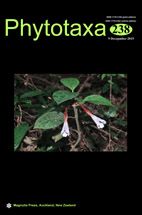Abstract
A new species of Phalaenopsis, P. pingxiangensis, from Guangxi, China, is described and illustrated. Detailed morphological comparison between the newly discovered orchid and other members of Phalaenopsis s.l. indicate that P. pingxiangensis is similar to P. marriottiana. The new species differs from the latter in its small stature, short inflorescence with two flowers, smaller and pink flower with pale yellow sepals abaxially, orbicular petals, purple-red, flabellate lip and terete column without wings. The molecular analyses of Phalaenopsis indicate that P. pingxiangensis is a distinct species nested in P. subgenus Hygrochilus. In addition, Hygrochilus tsii is transferred to Phalaenopsis.

